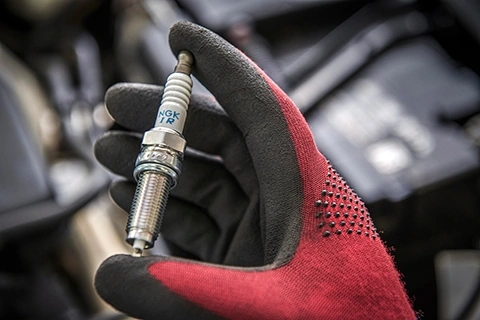Unique products designed to match up to the most extreme of conditions

Iridium IX
Designed specifically for the performance enthusiast, Iridium IX is a perfect example of NGK SPARK PLUG’s unique products that continue to thrive in extreme conditions. First launched in 2006, Iridium IX offers optimum sparking performance satisfying the Aftermarket demand of ambitious drivers who wish to upgrade a wide variety of vehicles that range from motorcycles and classic cars, all the way to boats. With Iridium IX, they are getting a high performing, modern iridium technology spark plug.
Iridium’s high performance credentials are demonstrated by its extremely high melting point of 2,450°C. To create this technology, engineers at the company put their more than 30 years’ experience and expertise in the manufacture of precious metal spark plugs to create yet another quantum leap in ignition technology.
Iridium IX features an ultra-fine 0.6mm diameter iridium alloy tip, laser welded onto the plug’s central electrode. Together, the slimmer iridium centre electrode and taper-cut ground electrode keep the required ignition voltage low, putting less strain on the ignition coil, whilst still managing to generate a powerful spark.
The precious metal spark plug’s high ignitability means that the engine ignites quickly and runs smoothly, even on cold mornings. It guarantees better fuel consumption and due to its ultra-fine centre electrode, also ensures fewer misfires; an issue more prevalent in standard plugs.
Iridium IX also features a special anti-fouling annular gap, which prevents carbon build up. This not only renders cold start issues a thing of the past, but also provides the best ever performance in stop-start traffic, where vehicles such as motorcycles need to excel.
Ceramic glow plugs
In contrast to petrol engines which are reliant on spark plugs to initiate combustion, diesel engines ignite spontaneously. This means that the injected fuel does not need a spark to ignite, or indeed the engine a spark plug. Instead, the fuel is combusted by the rapid compression of intake air, which reaches temperatures of around 900°C – high enough to ignite on its own.
During cold and extremely cold conditions, however, diesel engines require more energy to ignite because both the intake air and the components of the engine itself are colder. Additionally, pumping losses and compression are also higher, meaning that extra help is needed. This is where the glow plug performs its key function, rapidly rising in temperature to ensure a quick and smooth ignition.
NGK SPARK PLUG manufactures two main glow plug technologies: metal rod (sheathed) and ceramic. Although both can improve cold-start performance, it is ceramic glow plugs that provide extra high performance during extremely cold conditions.
Because of the high melting point of the ceramic which encases it, the glow plug can withstand very rapid heating to higher temperatures over extended periods; reaching a ‘pre-glowing’ temperature of more than 1000°C in less than two seconds, even in freezing conditions.
What’s more, ceramic glow plugs can sustain an ‘after-glow’ for more than ten minutes, at temperatures of up to 1,350°C. This not only eliminates cold knocking, but also reduces blue and white smoke; meaning less hydrocarbon and carbon-monoxide emissions.
Racing spark plugs
The culmination of ultra-extreme conditions is to be found in motorsport. This provides NGK SPARK PLUG with the ideal testing ground for its technology, with spark plugs used by racing teams in a variety of track and road competitions. These include the World Rally Championship, MotoGP, MXGP, Le Mans Series, Super GT, Super Formula and many others.
In Formula 1, some of the most extreme engine conditions are found. Featuring the fastest regulated road-course racing cars in the world, NGK SPARK PLUG has a long deep involvement in the sport, dating all the way back to 1964, when Honda became the first team to use and win a race with the company’s special spark plugs. Thus, began a period of unprecedented success, which saw the ignition specialist celebrate its 300th race win in 2013. Today, the ignition specialist provides spark plugs for a host of teams; a prestigious role not without its challenges.
Although similar to passenger car spark plugs in terms of shape and function, racing spark plugs are in fact very different. It is not unusual, for example, for long-life spark plugs such as the double precious metal ‘Laser Iridium’ to last distances of 100,000 km, whereas in Formula 1, it is perfectly normal for the plugs to be replaced after every race. This is due to the extreme conditions experienced in the sport where voltage between 20,000-30,000V is applied to the electrodes on the edge of the plugs, causing them to ignite. Much higher levels of pressure and combustion are a feature of the sport, with the gas temperature reaching up to 2,600°C, half as hot as the surface of the sun.
For engineers at NGK SPARK PLUG, motorsport provides unique challenges. Every season, new spark plugs need to be developed to conform to the specifications of the new engines. Each team’s engine, moreover, is a continual work in progress throughout the season, with the goal of improving its performance by milliseconds. This means that the spark plug experts are constantly on their toes, potentially having to redesign a team’s spark plug for each race. This, indeed, is a tricky endeavour, because changing one part of the design of a spark plug can have unforeseen consequences on another.
No matter the engine, NGK SPARK PLUG is at the forefront of what is technically possible in terms of ignition and sensor technology. This is a result of the company’s product testing, which is carried out in the most extreme conditions possible, satisfying customers and fans the world over.
 Niterra Press Releases
Niterra Press Releases








